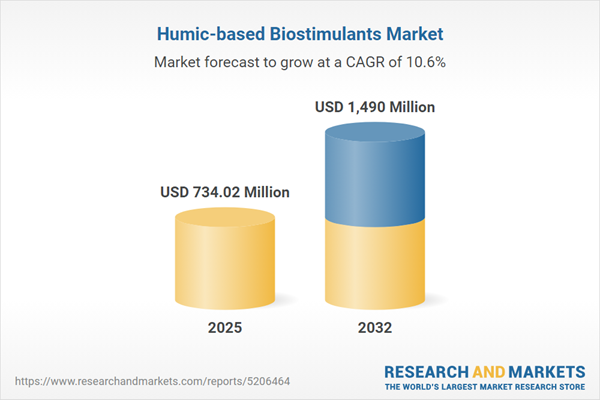Speak directly to the analyst to clarify any post sales queries you may have.
Humic-based biostimulants are increasingly recognized by senior decision-makers as vital agricultural inputs, supporting both productivity and sustainable practices for agribusinesses navigating complex market demands.
Market Snapshot: Humic-Based Biostimulants
The global humic-based biostimulants market is progressing at a strong pace, attaining a valuation of USD 668.02 million in 2024. Projections indicate further growth with a forecasted value of USD 734.02 million in 2025 and an expected USD 1.49 billion by 2032, reflecting a compound annual growth rate of 10.56%. The market’s ascent is propelled by a mounting focus on sustainable agriculture and dynamic policy frameworks, both of which encourage the integration of natural crop aids. The increasing adoption of digital agriculture solutions and ongoing advancements in product customization further reinforce sector growth, while major providers focus on regulatory compliance and differentiated performance to remain competitive.
Scope & Segmentation
This analysis brings targeted benchmarking and actionable intelligence to executive leaders, enabling informed oversight as agribusiness adapts to ongoing industry evolution. Segmentation delivers critical perspectives on the main operational, technological, and regional levers driving the sector forward.
- Product Form: Incorporates granule, liquid, and powder types, each supporting unique crop management strategies. Flexible deployment aligns with a range of operational requirements and scheduling preferences.
- Chemistry: Features formulations of humic acid and fulvic acid, with variants addressing soil health priorities and specific agronomic objectives for optimized crop performance.
- Crop Type: Compatible with cereals, grains, fruits, vegetables, oilseeds, pulses, turf, and ornamentals, promoting adaptability and enabling alignment with varied production systems and farmer needs.
- Source: Draws from feedstocks such as leonardite, lignite, and peat, supporting sourcing flexibility and adaptability across diverse agroecological settings.
- Application: Encompasses foliar spray, seed treatment, and soil amendment approaches, designed for seamless integration into different farm routines and supporting quick adjustment to regulatory or operational changes.
- Geography: Provides granular regional insights across Americas, Europe, Middle East, Africa, and Asia-Pacific, including in-depth profiles for the United States, Canada, Brazil, Germany, France, China, India, and Australia.
- Leading Companies: Examines the strategies of Bio Huma Netics, AgroLiquid ULC, Advanced Nutrients Ltd., Bayer AG, Haifa Group, Borregaard AS, FMC Corporation, Hello Nature, Humintech GmbH, Omex Group, VALAGRO S.p.A. by Syngenta, Yara International ASA, Live Earth Products, and Zhengzhou Shengda Khumic Biotechnology, focusing on their initiatives in scaling production and technology-driven innovation.
Key Takeaways for Senior Decision-Makers
- Humic-based biostimulants support the transition toward regenerative practices and bolster soil structure, resulting in more resilient cropping systems aligned with sustainability targets.
- Digital tools and precision agriculture technologies streamline regulatory compliance while enhancing resource efficiency, improving stakeholder outcomes across supply chains.
- Access to multiple product forms enhances operational agility, enabling managers to address supply fluctuations without compromising continuity or field performance.
- Collaboration among manufacturers, research institutes, and regulators is advancing organic and microbial technologies, facilitating greater adaptability and sector preparedness.
- Robust risk management and sophisticated supply chain strategies help protect against disruptions and proactively address evolving production requirements driven by policy shifts.
Tariff Impact on Market Dynamics
Recent updates to United States tariff structures are prompting organizations to fortify supplier relationships and refine inventory management along the humic-based biostimulants supply chain. These efforts focus on building more resilient networks and maintaining stable input availability during regulatory transitions and key planting windows.
Humic-Based Biostimulants: Methodology & Data Sources
Findings in this report derive from advanced market modeling, targeted analysis of policy and compliance standards, and robust review of field trial data. This approach blends direct industry expertise with rigorous empirical evidence, equipping decision-makers with reliable benchmarks for market entry and growth strategy.
Why This Report Matters
- Delivers executives timely insights into industry innovation cycles, technology uptake, and shifting market dynamics, facilitating agile planning and strategic action.
- Helps leaders address regulatory changes and supply chain volatility with proactive, data-driven solutions that enhance resilience across agribusiness operations.
- Equips organizations with tailored recommendations designed to meet specific regional and segment requirements, strengthening compliance and sustainability alignment.
Conclusion
Humic-based biostimulants play a pivotal role in reinforcing agribusiness resilience and supporting sustainable agricultural practices. This report empowers senior leaders to make well-informed decisions and navigate evolving commercial and regulatory environments with confidence.
Additional Product Information:
- Purchase of this report includes 1 year online access with quarterly updates.
- This report can be updated on request. Please contact our Customer Experience team using the Ask a Question widget on our website.
Table of Contents
3. Executive Summary
4. Market Overview
7. Cumulative Impact of Artificial Intelligence 2025
Companies Mentioned
The companies profiled in this Humic-based Biostimulants market report include:- Bio Huma Netics, Inc.
- AgroLiquid ULC
- Advanced Nutrients Ltd.
- Agritell Private Limited
- Bayer AG
- Haifa Group
- Borregaard AS
- Changsha Richfield Agri Tech.,Ltd.
- FMC Corporation
- Hello Nature, Inc.
- Humic Growth Solutions Inc.
- Humintech GmbH
- Omex Group
- Isagro Group by Gowan LLC
- Peptech Biosciences Ltd.
- Rovensa Group
- VALAGRO S.p.A. by Syngenta
- Yara International ASA
- Live Earth Products, Inc.
- Grower's Secret, Inc.
- Cifo Srl
- Swissgrow AG
- Zhengzhou Shengda Khumic Biotechnology Co., Ltd.
Table Information
| Report Attribute | Details |
|---|---|
| No. of Pages | 195 |
| Published | November 2025 |
| Forecast Period | 2025 - 2032 |
| Estimated Market Value ( USD | $ 734.02 Million |
| Forecasted Market Value ( USD | $ 1490 Million |
| Compound Annual Growth Rate | 10.5% |
| Regions Covered | Global |
| No. of Companies Mentioned | 24 |









